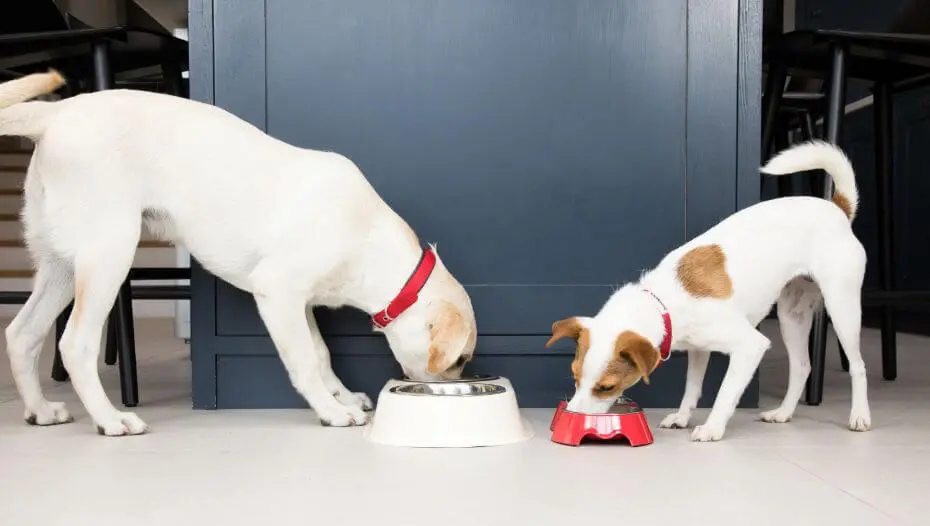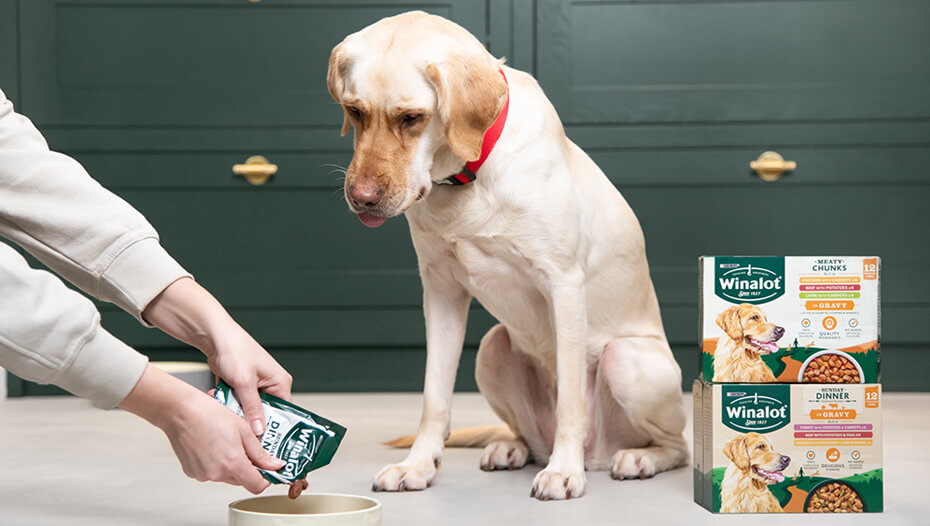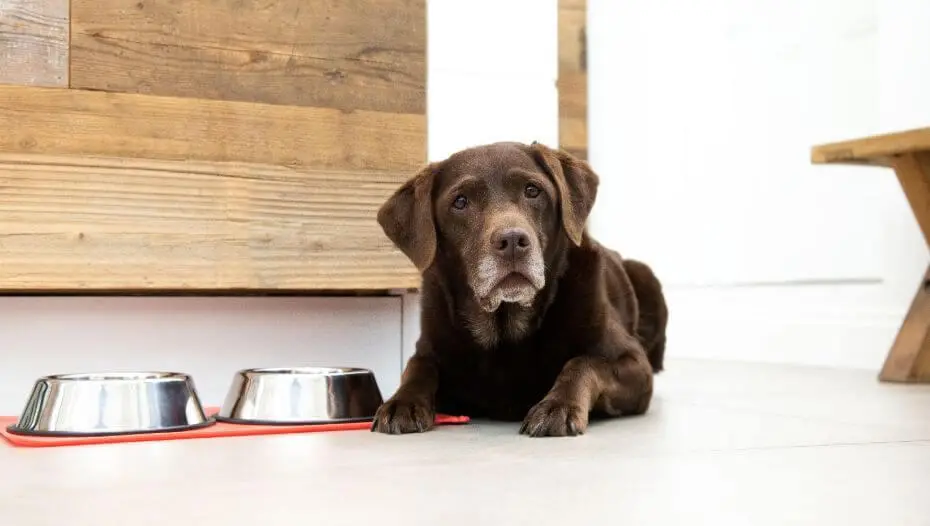Now that your once-tiny puppy has grown into a full-sized dog, it’s time to transition him or her over to adult dog food. This often occurs between 12 and 24 months of age, depending on the breed size.
Every canine has unique dietary needs, much like every human being. Your dog’s nutritional requirements will alter over time as their life stage, activity level, breed, size, and age are all considered. Here are some guidelines from our PetCare Team to help you choose how much and what kind of food to give your dog.
What kind of food should a dog eat?
Because of their omnivorous nature, dogs need a varied diet to maintain good health. This involves getting enough of each macronutrient, such as protein, fat, carbohydrate, and vitamin. Over fifty different laws in the UK regulate pet food, and in order to be considered “complete,” commercial pet food must include a certain minimum amount of certain nutrients. That’s why it’s important to provide your pet with a high-quality, complete meal that provides all the nutrients they require.
What is the recommended frequency of a dog’s feedings?
When people contact our PetCare service, they often question, “How often should I feed my dog?” Some mature canines have two meals a day, the canine equivalent of breakfast and supper. Until the puppy is at least six months old, however, it has to be fed more regularly, preferably three to four times each day. Three smaller meals per day might also be beneficial for certain toy and small-breed dogs. One-meal-a-day feeding is a common practice for owners of bigger breed dogs, but two smaller meals spread throughout the day may be more beneficial for pets who have a propensity to bolt their food. When you eat a lot of food quickly, it might cause stomach issues.
Consult your veterinarian if you are unsure of how frequently your dog should be fed.
Find an ideal spot
Put your dog’s mealtime away from the main part of the house’s activity. Always use a clean bowl to feed your dog, and do it on a tiled or similarly easy-to-clean surface. Put down a rubber feeding mat or invest in a bowl with a non-slip base if you notice your dog’s regular dish is always slipping.
Special anti-gulp dog bowls may help slow down dogs who wolf down their food, and an elevated dog feeder can be helpful for elderly dogs or dogs that are messy eaters.
Serving and storing food
Dogs will be more interested in and have an easier time digesting wet food (cans/tubs/pouches) if it is served at room temperature. So, remove it from the refrigerator about an hour before you want to eat it. It’s acceptable to heat it in the microwave briefly, but be sure it never gets too hot to eat!
Wet food spoils rapidly, so try not to leave it out for too long. Wet food, even if refrigerated, should be eaten within 24 hours after opening.
Instead, dry goods may be left out all day without becoming bad. Maintaining its smells and freshness requires that you keep it in a cool, dry place, preferably in an airtight container or resealable box.
While the majority of canines like their dry food in its dry form, some may benefit from having it soaked in water for up to 30 minutes before feeding. This is especially true if your dog has a sensitive stomach or if you need to avoid giving it to him due to a medical condition. Adding water to dry food will help eliminate plaque, but giving your pet a special dental treat on a regular basis is still a good idea. Keep in mind that the best approach to keep your dog’s teeth healthy is to clean them often.
Feeding and exercise
Don’t take your dog out for a walk within an hour of feeding time, and vice versa. Gastric dilatation and volvulus is a life-threatening illness that may affect large and gigantic breed dogs. This occurs when the dog’s stomach swells and the intestines twist. Your dog may show signs of illness such as being distressed and exhibiting abdominal distention and vomiting. If you are worried about your dog, please consult your veterinarian immediately.
What variables determine how much dog food a dog needs to eat?
To what extent you feed your dog depends on factors such as breed, size, age, lifestyle, and health. Guidelines for feeding your pet will often be found on the packaging of their food. Nonetheless, it’s important to feed your pet an appropriate amount so that its body condition score stays optimal. Taking into consideration breed size differences, body condition is a fantastic indicator of whether or not your pet is under or overweight. To ensure your dog is getting the right amount of food to maintain a healthy weight, it’s ideal to measure out each meal using a scale.

Keep in mind that if you give your pet treats, you should cut down on his or her regular meal, but try to limit treat feeding to less than 10 percent of the total amount of food given each day. If they don’t get a good variety of foods, their diet might become imbalanced.
When compared to larger dog breeds, the metabolic rate of toy and small-sized canines is substantially greater. Some smaller breeds may need twice as many calories per weight as bigger breeds, depending on their physical condition and degree of activity. When it comes to tiny dog food, formulations that are high in protein, lipids, and carbs are ideal since they provide the necessary energy boost that smaller dogs need. Also, the kibble sizes are tailored to canines with smaller jaws and stomachs.
Even though their metabolisms are slower, the bigger dog breeds have enormous appetites. Giant breed dog food is designed to suit the appetites of large dogs with kibbles that are bigger and meatier than the standard kind. These diets typically have lower fat content and higher protein concentration to help maintain peak physical shape.
You may want to feed your dog a diet designed for a “active” lifestyle if he or she has a highly active or working lifestyle. Extra fat, protein, and vitamins like B12 will be provided, all of which are necessary for the body to use food as fuel. It has been shown that taking vitamin E after intense exercise helps hasten muscle recovery.
Pregnant bickies are often advised to return to a high-quality puppy chow diet in order to get the extra calories and greater concentrations of other essential nutrients they require. You may learn more about what to feed a pregnant dog here.
‘Light’ formulas may be more appropriate for less active dogs since they include less fat and hence less of a risk of weight gain.
It is important to feed your dog a balanced diet, however, certain dogs may need a particular diet due to food allergies or health issues. These are all good reasons to see your vet before switching your pet to a new diet, to make sure the new food is appropriate for your pet’s health.
Talk to your doctor or veterinary assistant if you need help deciding what kind of food is best for your dog.
Can you recommend a good resource for locating a dog feeding chart?
The container of your dog food should include a feeding chart. Starting with these recommendations, you may change your pet’s serving size to help them maintain a good body condition score. This simple checklist can help you determine whether your dog is overweight.
What’s better, moist or dry, for your dog?

Wet or dry food is a question of personal choice, both for you and your dog. Fussy dogs may prefer wet food because of its richer aroma and flavor. Veterinarians often recommend moist dog food to assist enhance water consumption for canines with renal or bladder problems. Dry foods are often lower in fat and made to be better for your teeth. For obese dogs, this may be a useful tool in the fight against their weight.
Some pet parents mix wet and dry food, which might be beneficial in case you ever need to switch your dog over to a different diet. Any high-quality, complete adult dog food will give your dog with the ideal mix of nutrients, so there’s no need to worry about whatever formula you pick.
Specialty diets for dogs with health problems
Inquire about therapeutic diets, or specialized adult meals, from your veterinarian if your dog has preexisting conditions including skin or gastrointestinal sensitivities. To aid in the treatment of a certain medical condition, they will be designed to include all of the necessary vitamins, minerals, and other nutrients. Only do so on the advice of a veterinarian, since the amounts of various nutrients they contain may exceed or fall short of what a healthy pet needs.
After your pet reaches the senior age range (usually between 6 and 7 years), you may start thinking about switching them over to a senior diet from a standard adult meal if they haven’t already. To learn more about what to feed your senior dog, click here.
It’s important to keep an eye on your dog’s weight, since drastic changes might mean it’s time to rethink his or her food or see the clinic.
What restaurant will provide your dog’s meal?
Put your dog’s mealtime away from the main part of the house’s activity. Always use a clean bowl to feed your dog, and do it on a tiled or similarly easy-to-clean surface. Put down a rubber feeding mat or invest in a bowl with a non-slip base if you notice your dog’s regular dish is always slipping.

Dogs who like to scarf down their food might benefit from puzzle feeders or dog bowls that force them to chew their food more carefully. A elevated dog feeder may be more convenient for older dogs or sloppy eaters.
To prevent bullying and in-fighting between family canines, it’s best to feed each dog individually at the same time.
Do I need to give my dog treats?
While it’s important to show our dogs some affection, it’s also important to make sure they aren’t getting too many extra calories from sources other than their regular diet. The number of rewards and their frequency should be determined by the kind of treat being given. Treats, biscuits, and chews should make up no more than 10 percent of your dog’s daily calorie consumption at the most.
There’s no reason for your dog to feel left out just because they can’t have the same goodies as their pals while following a diet prescribed by their veterinarian. A part of their regular diet might be used as training rewards.
Dental chews and other similar snacks are available in various sizes to accommodate canines of varying sizes.
If you’re not sure how many treats to give your dog, it’s best to follow the recommendations on the packaging and consult your doctor or vet nurse if necessary.
Exactly what you shouldn’t give your dog
When considering what to feed your dog, it’s as important to know what not to offer it. Table scraps should be avoided whenever possible since certain human meals may be harmful to or even poisonous for pets. Occasionally spoiling your pet is OK, but treats shouldn’t make up more than 10% of their daily diet. Our useful guide will tell you what foods and substances are dangerous to dogs, so you can avoid feeding them to yours.
For anyone looking to make dietary adjustments to their dog, here is a helpful chart
When switching from adult pet food to senior pet food, for instance, it may be necessary to alter your dog’s diet. The digestive system might be thrown off if you make drastic dietary changes all at once (over 7-10 days).
Offer the new meal with their regular diet, or introduce it gradually
Start by adding a little bit of the new food and gradually increasing it over the period of 7-10 days, while decreasing the amount of the old food.
If you’re switching from wet to dry food, your dog will need to get used to the new texture. At first, they may chew it more actively, take longer to eat and almost certainly will want more water. The extra chewing time is a good thing as it promotes dental health and it doesn’t imply that your dog is enjoying their dry food any less than their wet.
Customers who are transitioning from dry to wet may drink less and notice the absence of crunch. A handful of biscuits may be thrown in at any time to up the textural ante. Keep in mind that the visual appearance of a serving of dry food may be deceptive, since it may seem smaller than a serving of canned food. You may feed your dog a lesser quantity of dry food and yet provide the same amount of energy as you would with a bigger amount of wet food since dry foods are more calorie-dense.
Talk to your vet if your dog is being picky about eating new foods, even if they were suggested by your physician. Fear not. Fortunately, there are likely other foods you may try or methods you can use to get them to eat.
We feed our mature dogs Purina products
Purina is responsible for several of the best-selling dry and wet adult dog meals in the UK. We provide a wide variety of recipes for both wet and dry dog food, suitable for all stages of your pet’s life.